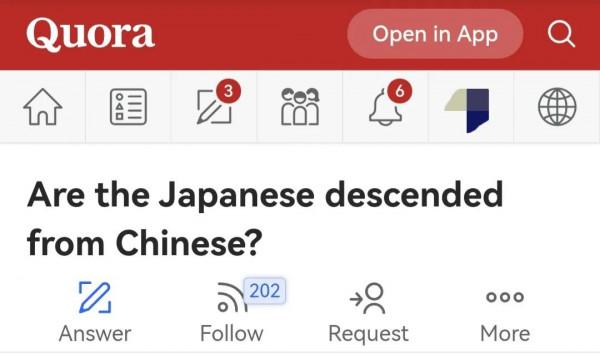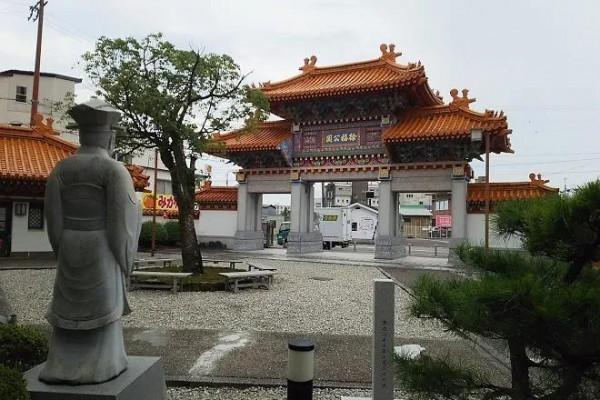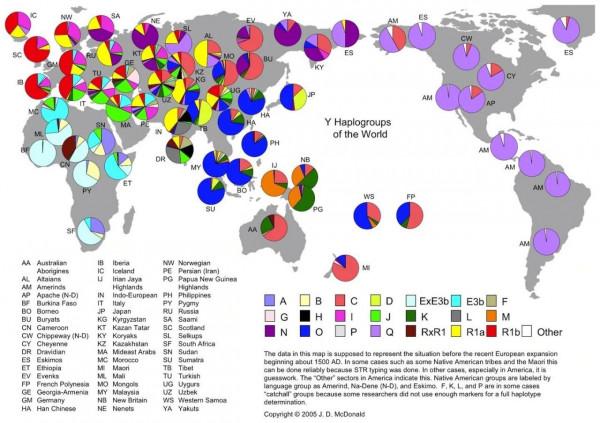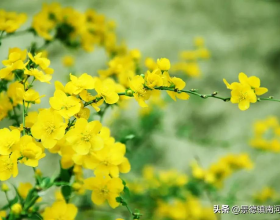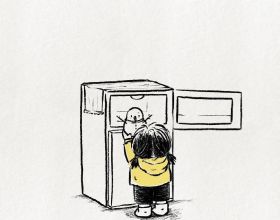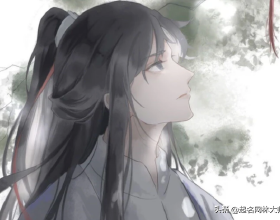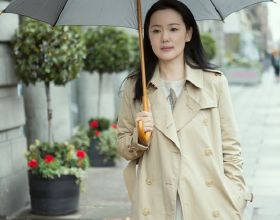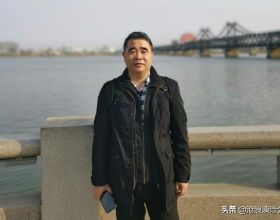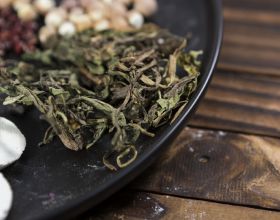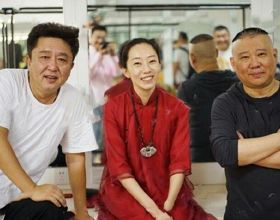在海外知名問答網站Quora上,一名日本網友提問道:日本人是中國人的後代嗎?這個話題引起了諸多海外網友的關注和熱議。來自日本的專家稱根據基因測序和歷史資料記載來看,很大程度上確實如此,他專門撰文回答了該網友的問題。

日本專家晃坤的回答
A large number of archaeological evidence shows that thousands of years ago, a large number of farmers poured into Japan from the Asian continent. They are called maisheng people. With the overwhelming advantage of production technology, they replaced the rope pattern people mainly engaged in hunting and gathering in Japan.
大量考古證據表明,數千年前,有大量農民從亞洲大陸湧入日本,他們被叫做彌生人。他們憑藉生產技術的壓倒性優勢取代了日本本土主要從事狩獵採集的繩紋人。
The mitochondrial DNA analysis of Japanese rope literati and modern Japanese samples shows that there is discontinuity between the mitochondrial DNA of residents in rope literati era and modern Japanese. It may be that in the Yayoi era, there was a conflict between the aboriginal rope literati and the Yayoi. The Yayoi were much more advanced than the rope literati in terms of weapons and productivity. At that time, the rope literati were still in the stone age and far behind the Yayoi. Therefore, the rope literati were defeated in this conflict and had to move to Hokkaido island. In the ancient tomb era, the rope literati have completely integrated with the maisheng people to form a Dahe nation.
對日本繩文人和現代日本樣品的線粒體DNA分析表明,繩文人時代居民和現代日本人的線粒體DNA存在不連續性。可能是彌生時代的時候,原住民繩文人和彌生人發生了衝突,彌生人在武器、生產力等方面比繩文人要先進得多,而繩文人當時還處於石器時代,大大落後於彌生人,因此繩文人在這場衝突中落敗,不得不往北海道島遷移。而到了古墳時代繩文人己經完全和彌生人融合形成大和民族了。
The deathbed period was named after an area near Tokyo, where archaeologists discovered the cultural relics and remains of that era for the first time. The remarkable characteristics of the Yasheng period include the style of Yasheng pottery and the formation of rice field intensive rice agriculture. The hierarchical structure of Japanese society began in this period, and this feature originated in China. From the south of Kyushu to the north of Honshu, maisei culture flourished.
彌生時期是以東京附近一地區命名的,考古學家在那裡首次發現了那個時代的文物和遺存。彌生時期的顯著特徵包括彌生陶器風格和稻田密集型水稻農業開始形成。日本等級社會階層結構始於這一時期,而這一特徵起源於中國,從九州南部到本州北部這片區域內,彌生文化蓬勃發展。
During the dying period, the culture of China and its vassal state Korea reached Japan at different times in the following centuries. China's influence is evident in bronze and copper weapons, Taoist temples and irrigated rice cultivation. The three main symbols of maisheng culture are copper mirror, copper sword and royal seal stone.
在彌生時期,中國其藩屬國朝鮮的文化在後來的幾個世紀的不同時期到達日本。中國的影響在青銅和銅製武器、道場以及灌溉水稻種植方面非常明顯。彌生文化的三個主要標誌是銅鏡、銅劍和皇家印章石。
Archaeological evidence shows that maisheng culture is related to the Yangtze River Delta
考古證據表明彌生文化與長江三角洲有關
From 1996 to 1999, a team led by Cong Yamaguchi, a researcher at the National Museum of natural sciences of Japan, found maisheng remains in Yamaguchi and Fukuoka counties of Japan and compared them with those in Jiangsu Province along the coast of China. The research team found many similarities between the remains of maisheng and Jiangsu. DNA testing further linked maisheng to the Yangtze River region of China.
1996年至1999年間,由日本國家自然科學博物館研究員山口聰領導的團隊在日本山口縣和福岡縣發現的彌生遺骸與中國沿海江蘇省的彌生遺骸進行了比較。研究小組發現了彌生和江蘇遺骸之間的許多相似之處。DNA測試進一步將彌生與中國長江地區聯絡起來。
DNA tests show that some of the earliest rice growers in Japan may have migrated from the lower reaches of the Yangtze River in China more than 2000 years ago. Genetic similarity was found between the human remains of the dying period found in southwest Japan and the early Han Dynasty remains found in Jiangsu Province, China. Scientists say the people who introduced irrigation technology to the Japanese Islands either came from the Korean Peninsula opposite the Tsushima Strait or from northern China opposite the Yellow Sea.
DNA測試表明,日本一些最早的水稻種植戶可能是2000多年前從中國長江下游流域移民過來的。在日本西南部發現的彌生時期的人類遺骸和中國江蘇省發現的漢代早期遺骸之間發現了基因相似性。科學家稱,向日本群島引進灌溉技術的人要麼來自築島海峽對面的朝鮮半島,要麼來自黃海對面的中國北方。
It is said that China's first emperor (Qin Shihuang) dreamed of immortality and sent Xu Fu (Zhu Fu in Japanese legend) and thousands of young men and women to look for immortality medicine. A team led by Xu Fu is said to have landed in today's Kumano area of Japan's triple county. Later, Xu Fu decided to stay in Xingu and never returned to the state of Qin. The agricultural technology and knowledge brought by Xu Fu are said to have greatly improved the quality of life of the ancient Japanese.
傳說中國的第一位皇帝(秦始皇)幻想長生不老,派遣徐福(日本傳說中的朱福)和成千上萬的年輕男女一起尋找長生不老藥。徐福帶領的一隊人馬據說在今天的日本三重縣熊野地區登陸。後來徐福決定留在新谷,再也沒有回到秦國。徐福帶來的農業技術和知識據說極大地提高了古代日本人的生活質量。
In the 15th century, Tokugawa shuntengbu, the Lord of Guiqiu, placed a tombstone in shingu to commemorate Xu Fu. In 1994, Xingu city built a memorial park around Xu Fu's tombstone and named it "Zhou Fu Memorial Park". In any case, Xu Fu's departure from China is generally consistent with the Yayoi civilization in Japan.
15世紀,貴秋的領主德川順藤部在新谷(Shingu)安放了一塊墓碑以紀念徐福。1994年,新固市在徐福墓碑周圍修建了一座紀念公園,並將其命名為“周福紀念公園”。無論如何,徐福離開中國與日本出現的彌生文明大體上是一致的。
Records of Japan in ancient China
中國古代關於日本的記錄
The earliest written records about the Japanese came from Chinese historical materials in the dying period. Wo, the pronunciation of early Japanese Chinese names, was mentioned in AD 57; At the end of the Han Dynasty, Emperor Guangwu gave NaVO a gold seal. This event was recorded in the book of the later Han Dynasty compiled by Fan Ye in the fifth century. This seal was later found in the north of Kyushu in the 18th century. In 257 ad, the annals of the Three Kingdoms compiled by Chen Shou, a scholar of the third century, also mentioned "he nationality".
關於日本人的最早書面記錄來自於尚在彌生時期的中國史料。WO,是日本早期中文名字的發音,在公元57年就被提及了;漢末廣武皇帝給了那沃國一枚金印。這一事件被記錄在五世紀范曄編纂的《後漢書》中,這枚印章後來於18世紀在九州北部被發現。公元257年,三世紀學者陳壽編纂的《三國志》也提及了“和族”。
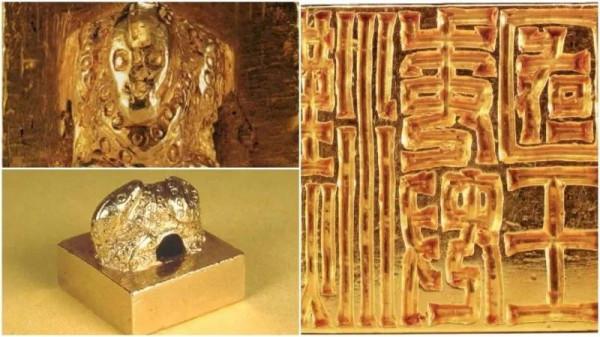
1784年在日本福岡縣的Shikanoshima島上發現的Na國王金印。
Ancient Chinese books in the third century also recorded that the Japanese lived on raw fish, vegetables, bamboo and rice on wooden trays, clapped their hands and worshipped (the shrine still does this), and built mounds for sacrifice. They also maintained patriarchal relations, collected taxes, owned provincial granaries and markets, and the basic feature of society was violent struggle.
三世紀的中國古籍還記載說,日本人以生魚、蔬菜和竹子和木製托盤上的大米為生,拍手朝拜為禮(神社至今仍在做這件事),並建造土墩祭祀,他們還保持著宗主關係,收稅,擁有省級糧倉和市場,社會的的基本特徵是暴力鬥爭。
In Wei Zhi, it first mentioned Yamataikoku (邪馬臺國) and sharmaness Queen Himiko (卑彌呼), and chronicled a tributary relationship between Himiko and the Cao Wei Kingdom (220–265AD) during the Three Kingdom period. It recorded that the Yayoi people chose her as ruler following decades of civil war. Early Japanese histories do not mention Himiko, but historians associate her with legendary figures such as Empress Consort Jingu, who was regent (200–269AD) in roughly the same era as Himiko.
在《魏志》中,它首先提到了山太國(邪馬臺國) 還有夏曼內斯女王希米科(卑彌呼), 並記載了三國時期日美子與曹魏國(公元220-265年)的朝貢關係。據記載,經過幾十年的內戰,彌生人選擇她為統治者。早期的日本歷史中沒有提到日美子,但歷史學家將她與金谷皇后等傳奇人物聯絡在一起,金谷皇后與日美子大致處於同一時代,是攝政王(公元200-269年)。
Wei Zhi mentioned that the Chinese envoys sent by the kingdom of Cao Wei to Japan recorded that some Japanese scholars believe that the Dahe people and the Dahe dynasty may be the descendants of the ancient Chinese feudal state of Wu, or even the direct descendants of Tiber. Wu Taibo is a historical figure of the state of Wu in the Yangtze River Basin of China.
《魏志》提到曹魏王國派往日本的中國使節記載,倭人的 一些學者認為,大和人和大和王朝可能是中國古代封地吳國的後裔,甚至是泰伯的直接後裔。吳泰伯是中國長江流域吳國的歷史人物。
In history, Taber was the eldest son of Duke Zhou. When King Zhou wanted his youngest son to become crown prince, Taber and another brother left for the southeast and settled in today's Jiangsu Province. There, Taber and his followers established the state of Wu. Taber's nephew, King Wu of Zhou, later overthrew the Shang Dynasty and established the Zhou Dynasty. Taber is also known as Wu, the ancestor of all Chinese people (吳).
歷史上,泰伯是周公的長子。當週國王希望讓他的小兒子成為王儲時,泰伯和另一個兄弟離開了,前往東南部,在今天的江蘇省定居。在那裡,泰伯和他的追隨者建立了吳國。泰伯的侄孫,周武王後來推翻了商朝,建立了周朝。泰伯也被稱為吳姓所有中國人的祖先(吳)。
Part of it is true, although most Japanese are reluctant to admit it.
一部分確實如此,雖然大多數日本人不願意承認。
There are at least three previous genetic groups that make up the current Japanese.
目前的日本人至少有三個遺傳下來的基因群。
The first category is more closely related to the indigenous peoples of the Philippines, Taiwan Island and Okinawa. They may have been the first people to come to the Japanese islands, but they were expelled to the far north by later residents.
第一類與菲律賓原住民、臺灣島原住民和沖繩人的關係更為密切。他們可能是第一批來到日本群島的人,但被後來的居民驅逐到了極北之地。
The second category is related to Mongolian and Korean, from the Korean Peninsula. At the beginning of the last glacial maximum about 28000 years ago, the Japanese islands could enter through the Korean Peninsula and move between the Korean Peninsula. From 16000 to 17000 years ago, due to sea level rise, the expansion of the Korean Strait may lead to the subsequent isolation of the Jomon lineage from the rest of the mainland. These time ranges are also consistent with the oldest evidence of rope pottery production.
第二類與蒙古族和朝鮮族有關,來自朝鮮半島。在大約28,000年前的末次冰盛期開始時,日本群島已經可以透過朝鮮半島進入,從而能夠在朝鮮半島之間移動。16,000到17,000年前,由於海平面上升,朝鮮海峽的擴大可能導致隨後繩文世系與大陸其他地區隔離。這些時間範圍也與繩紋陶器生產的最古老證據相吻合。
The third time came from southern China. Maisheng, one of the ancestors of modern Japanese, has the genetic characteristics widely existing in Northeast Asia such as Liaohe River Basin in Northeast China. On the other hand, Gufen people have many genetic characteristics in East Asia, and this characteristic is basically consistent with the genetic characteristics of modern Japanese. Some people speculate that the ancestors of modern Japanese are mainly immigrants from all over southern China.
第三類來自中國南方。現代日本人祖先之一的彌生人,具有中國東北的遼河流域等東北亞地區廣泛存在的遺傳特徵。另一方面,古墳人則有很多東亞大陸所具有的遺傳特徵,而且這一特徵與現代日本人的遺傳特徵基本一致。有人據此猜測,現代日本人的祖先主要是由中國南方各地渡海而來的移民。
As for the cultural influence, it is inevitable that most of Japan's cultural traditions come from China, and a considerable part of them are spread through North Korea. Almost all Japanese culture was rooted in China in the past. From written books to architecture and diet, even the whole samurai culture is based on the myth of heroes in the romance of the Three Kingdoms.
至於文化方面的影響更是不可避免,日本的文化傳統絕大多數來自中國,其中相當一部分透過朝鮮傳播進入。幾乎所有的日本文化在過去的某個方面都根植於中國,從文字書籍到建築飲食,甚至整個武士文化都是基於《三國演義》中英雄的神話。
Many Japanese history involves Japan's admiration and imitation of China, which is shameful - just as most European countries are willing to be influenced by the Romans, this is the only way for the evolution of civilization.
很多日本歷史都涉及到日本對中國的仰慕和模仿,這一點都不可恥——就像大多數歐洲國家樂於受到羅馬人的影響一樣,這是文明演進的必由之路。

